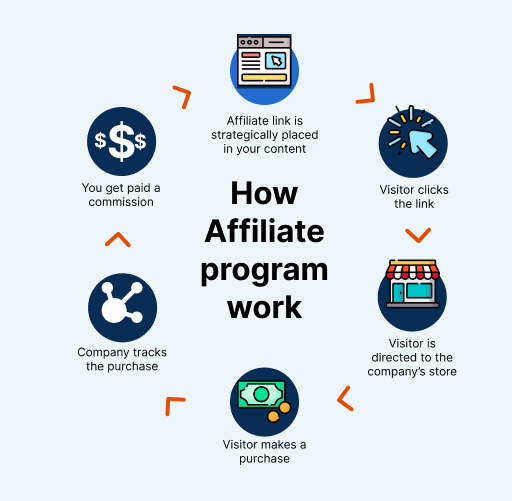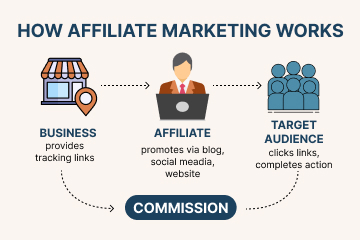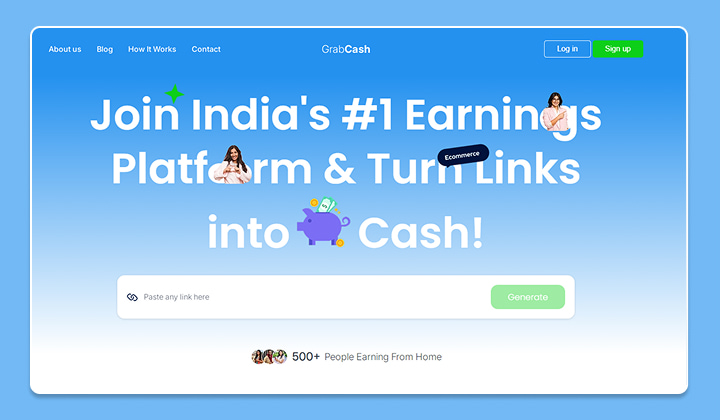Imagine earning money while you chill, travel the world, or even catch up on your favorite shows. This is the reality of affiliate programs.
Affiliate programs are marketing strategies where businesses collaborate with individuals or affiliates to promote their products or services. In exchange, affiliates earn a commission for each sale, lead, or action generated through their promotional efforts. This benefits both parties, and businesses gain increased visibility and sales, while affiliates earn passive income.
The global affiliate marketing industry was valued at $18.5 billion in 2024 and is projected to exceed $30 billion by 2030. According to IAMAI, the market is expected to exceed $835 million in India by 2025. The industry’s growth is fueled by high Return on Investment, scalability, and low operational risk for businesses.
How do Affiliate Programs Work?

Affiliate programs create a system in which businesses partner with affiliates to promote their products or services. Here’s more on how it works:
- Affiliates join a business’s affiliate program or sign up on GrabCash easily.
- They receive unique tracking links or codes tied to their accounts.
- Affiliates can use these links to promote the business through websites, blogs, social media, or email campaigns.
- When a customer clicks an affiliate’s link and completes a desired action (e.g., purchase, signup), the program tracks through cookies or tracking IDs.
- The affiliate earns a commission based on the action, such as a percentage of the sale or a fixed fee.
- GrabCash then pays affiliates on a predefined schedule, often monthly or after reaching a minimum payout of ₹10.
Types of Affiliate Programs
Affiliate marketing is about driving traffic, generating leads, or closing sales for a merchant through tracked referral links. Understanding the different types of affiliate programs, such as pay-per-sale, pay-per-click, or recurring commissions, can help you choose the right fit and maximize your earning potential. Read on for more details:
1. Pay-Per-Sale (PPS)
Pay-per-sale is the most common affiliate model, where you earn a commission only when someone buys a product through your referral link. It’s performance-based, so you only get paid when you deliver real value. This model is best for affiliates who can build trust and influence purchase decisions, such as bloggers, YouTubers, and niche content creators.
2. Pay-Per-Click (PPC)
In pay-per-click programs, you earn money every time someone clicks your affiliate link, regardless of whether they buy anything. It’s all about driving traffic. While the payouts are usually low per click, high-traffic websites or ad-heavy platforms can make this model profitable.
3. Pay-Per-Lead (PPL)
Pay-per-lead programs reward you when a user takes a specific action, like signing up for a newsletter, filling out a form, or starting a free trial. It’s a sweet spot between clicks and sales, offering decent payouts without needing a purchase. This model suits affiliates in niches like finance, education, or SaaS, where lead generation is key.
4. Two-Tier Affiliate Programs
Two-tier programs let you earn from your referrals and the affiliates you recruit. Think of it as affiliate marketing with a referral bonus. It’s not multi-level marketing, but it does reward you for building a network. Great for experienced marketers who can mentor others or build affiliate communities.
5. Recurring Commission Programs
Recurring commission programs pay you every month as long as the customer you referred stays subscribed. It’s like building passive income over time. This model is great for promoting subscription-based services such as software, memberships, or hosting platforms. The upfront effort pays off with long-term rewards.
6. CPA (Cost Per Action) Networks
CPA networks offer a wide range of offers where you get paid when users complete specific actions such as downloads, installs, sign-ups, or purchases. It’s a flexible model with high earning potential, especially for performance marketers who run paid ads or email campaigns. But it requires solid tracking and optimization skills.
7. Influencer Affiliate Programs
These programs are great for social media influencers who promote products using custom links or discount codes. Brands often provide exclusive perks or higher commissions to influencers with engaged audiences. It’s less about technical marketing and more about authenticity, reach, and personal branding.
8. B2B Affiliate Programs
B2B affiliate programs focus on business products and services such as CRM tools, analytics platforms, or enterprise software. The sales cycles are longer, but the commissions are often much higher. This model is ideal for consultants, agencies, or content creators in the business or tech space who can influence professional decisions.
What are the Highest Paying Affiliate Programs on GrabCash?
Myntra and Ajio are among the most popular affiliate programs on GrabCash, offering up to 8% commission rates to affiliates. If you’re looking to make the most out of your affiliate earnings, explore our detailed guide on getting started with the Myntra Affiliate Program.
In addition to these, other prominent brands such as Levi’s, Plum, and Nykaa provide excellent earning opportunities for affiliates. Here’s a detailed table showcasing some of the top affiliate programs on GrabCash:
| Brand | Industry | Commission Rate | Special Features |
| Myntra | Fashion | Up to 7.2% | Exclusive seasonal campaigns |
| Ajio | Fashion | Up to 8% | Attractive fashion deals and discounts |
| DermaCo | Skincare | Up to 21.6% | High-demand skincare products |
| Forrest Essentials | Beauty | Up to 13.6% | Luxury Ayurveda-based products |
| Plum | Beauty & Wellness | Up to 14.4% | Eco-friendly and vegan beauty products |
| Levi’s | Fashion | Up to 9.6% | Iconic global fashion brand |
| Nykaa | Beauty | Up to 7.44% | Comprehensive range of beauty products |
| Shyaway | Fashion | Flat ₹320 | Specialized lingerie collections |
| Goibibo | Travel | Flat ₹320 | Bonuses on flight and hotel bookings |
| ClearTrip | Travel | Flat ₹240 | Strong travel offers and seasonal deals |
Key Benefits of Affiliate Programs
| Benefits of Affiliate Programs for Businesses | Benefits of Affiliate Programs for Affiliates |
| Cost-effective marketing model | Opportunity to earn passive income |
| Increased brand visibility and reach | Flexible work schedule and independence |
| Performance-based payment ensures ROI | Minimal upfront investment required |
| Access to a diverse network of affiliates | Access to promotional tools and resources |
| Scalable strategy for customer acquisition | Ability to promote products of interest |
| Improved website traffic and sales conversions | Potential to earn high commissions |
| Measurable results with detailed analytics | Partner with reputable brands for credibility |
Affiliate Programs and Affiliate Marketing
Affiliate marketing is a powerful performance-based marketing strategy where businesses reward affiliates for driving traffic, leads, or sales through their promotional efforts. Affiliate programs are the backbone of affiliate marketing. It offers affiliates the necessary tools, such as personalized tracking links, performance analytics, and payment systems, to increase their promotional efforts.
How does affiliate marketing work
Affiliate marketing works by connecting businesses with affiliates who promote their products or services to a target audience. Affiliates use unique tracking links provided by the business or its affiliate program to share through blogs, social media, or websites.
When a user clicks on the link and completes a desired action, such as making a purchase or signing up, the affiliate earns a commission. It’s a simple setup with real potential, and the benefits of affiliate marketing make it a smart move for anyone looking to earn online.

How do I get started on affiliate marketing?
Affiliate marketing is one of the easiest ways to earn money online, especially in 2025, and GrabCash makes it super beginner-friendly. You don’t need a website, coding skills, or a big budget. All you need is a smartphone, curiosity, and a willingness to learn. Follow these steps to get started:
Step 1: Pick Something You Care About

Pick a niche you like or can learn to like. Your niche is the topic or category you’ll focus on, such as fitness gear, pet supplies, or budget travel. Don’t just chase trends. Pick something you’re genuinely interested in or at least curious about. Why? Because you’ll be talking about it.
A good test: Google something like “Best yoga mats for beginners” or “Top hiking boots for summer.” If big brands dominate the first page and lack small creators, it may be too competitive. You can also explore Amazon or Flipkart to see what people are buying; sometimes, the best niches are hiding in plain sight.
Step 2: Skip the Tech Drama, Join GrabCash

Don’t worry about building a website. Just create a free account on GrabCash. It connects you with affiliate offers from top brands. Once you’re in, you’ll get special links (called affiliate links) that track your referrals. When someone clicks your link and buys something, you earn a commission. It’s that simple. No tech headaches, no domain names, no hosting.
Step 3: Pick Problem-Solvers, Not Just Pretty Products
Choose products that sell, and GrabCash helps you with this. You’ll find tons of high-demand brands with products across different categories. Don’t just pick what looks cool, pick what solves a problem. For example, a “portable blender” might appeal to fitness lovers, while a “budget travel backpack” could be perfect for students.
Look for products with good reviews and decent commissions. And don’t try to promote everything, focus on a few solid products that match your niche.
Step 4: Social Media is Your Stage

You don’t need a blog; you need attention. Use social platforms like Instagram, YouTube Shorts, WhatsApp, and Facebook to share your affiliate links. Create short videos, reels, or posts that show how the product works or why it’s useful.
For example, a quick “Top 3 gadgets under ₹500” reel can get tons of views. Use trending hashtags, reply to comments, and stay consistent. You’re not selling, you’re recommending.
Step 5: Crack the Code with Click Insights
GrabCash provides basic analytics to see which links are getting clicks and which ones are converting. Use this info to double down on what’s working. If a certain product or post has traction, make more content around it. If something’s not working, tweak your approach or try a different product. It’s all about testing and learning.
Step 6: Patience and Persistence
Affiliate marketing isn’t a get-rich-quick scheme. But if you stay consistent, keep learning, and genuinely try to help people, it can become a great side income or even a full-time gig. The key is to stay patient, keep experimenting, and don’t give up after a few posts. Every successful affiliate marketer started with 0 followers and 0 sales.
Affiliate Marketing Mistakes to Avoid
Affiliate marketing can be highly profitable, but it’s important to avoid key pitfalls. Promoting low-quality products or spamming links can harm your credibility, while neglecting audience needs may lead to low engagement. Focus on building trust and creating genuine value for your audience. Here are more key mistakes you should avoid as an affiliate marketer;
- Promoting products you don’t care about can make your recommendations seem fake and unreliable.
- Spamming your links everywhere may upset people and damage your reputation.
- Ignoring your audience’s needs means you’re not providing real value, which is important for success.
- Choosing low-quality products or sketchy brands can hurt your credibility and reduce trust.
- Being too pushy with sales can alienate your audience and make them less likely to engage.
- Not disclosing affiliate links violates trust and may breach legal guidelines.
- Overloading your audience with too many products can confuse them.
- Skipping analytics means you’re missing opportunities to improve your strategy and results.
- Giving up too soon prevents you from seeing the long-term potential of affiliate marketing.
- Not building relationships with your audience can result in lower engagement and fewer sales.
To Conclude
Affiliate marketing continues to thrive as an important aspect of digital commerce. With increasing reliance on data analytics and AI-driven optimization, the future promises more personalized campaigns and higher conversion rates. Innovations like influencer-driven affiliate strategies and blockchain-powered tracking are reshaping affiliate programs, ensuring transparency and fairness. For both businesses and affiliates, the opportunities are boundless, an exciting era of growth and innovation lies ahead.
Frequently Asked Questions
How to find affiliate programs?
To find affiliate programs, GrabCash is an excellent option. You can browse their dashboard for a variety of affiliate opportunities on top brands like Myntra, Ajio, Flipkart, and FirstCry, sign up for free, and start promoting products with tracking tools to monitor your performance and earnings.
Is it illegal to do affiliate marketing?
No, affiliate marketing is legal in most countries. However, affiliates must comply with advertising laws, such as disclosing affiliate links and avoiding deceptive practices.
What are some free affiliate programs?
Free affiliate programs include Amazon Associates, eBay Partner Network, and Google AdSense. Others like GrabCash require no upfront fees. Many brands, such as Myntra, Ajio, and Levi’s, also offer free programs through affiliate platforms.
Is affiliate marketing still worth in 2025?
Yes, affiliate marketing remains a great earning opportunity in 2025, with continued growth in e-commerce and digital marketing. Its performance-based model ensures value for businesses and affiliates.






